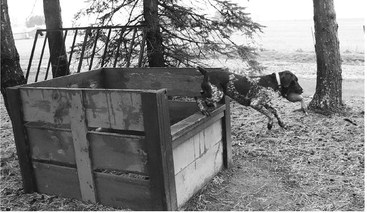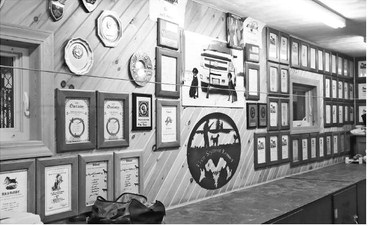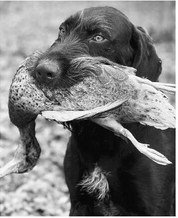though he has trained other ….


though he has trained other breeds like German wirehaired pointers, Labs and wirehaired pointing Griffons. When I interviewed him, he had plans to leave for Arizona soon to go quail hunting.
Aumann has trained extensively himself, enabling him to pass his knowledge on to his clients. He has completed all levels of the Huntsmith Training seminars, following the training methods of Rick and Ronnie Smith. In 2004, he finished his advanced training and now he leads these seminars.
“I had a guy come in from Alabama last year and spend two days with me. And I was training him on how to train his dogs. And I’ve had guys from Iowa, from Alaska. They just come out of the woodwork to find out how to train these dogs to a different degree than what most people do,” he said.
“I actually spend a lot of time training the people, as much as training the dogs,” he said. “Because if I can train the person, and the person can train the dog what I teach them, it’s golden. But honestly, more people want me to just do it because I’ve been doing it so long.”
Every spring and summer, Aumann trains dogs at his home kennel just outside of Loyal, with eight or nine dogs being boarded at any given time. Dogs usually stay there between four and six months, depending how long it takes them to learn skills. Training starts around April and lasts through the first week of October or so. Aumann takes in dogs from all over the country that people want him to work with to help take them to the next level.
Aumann teaches the dogs how to hunt using a variety of methods, including force fetching, a retrieving training method in which a handler uses aversive stimulus, most commonly an ear pinch, toe hitch, and/or ecollar stimulation, to teach a dog that it can turn off that aversive stimulus by interacting with a target object that the handler wants to teach the dog to retrieve.
He also trains the dogs for blood tracking and shed retrieving, so if a hunter shoots a deer in the fall, the dog can follow the blood trail to the animal. In the spring when the deer lose their antlers, the dogs learn how to locate them.
“I start them as a 4- or 5-month-old puppy to go retrieve sheds,” said Aumann.
Initially when Aumann gets a dog, he works on obedience and the dog becoming comfortable with their handler. Starting at 7 or 8 weeks, he trains the dog to not mind having someone look in their mouth and to hold a person’s hand in their mouth without biting down.
“We do that because that’s the start of the force fetch, the retrieving part of it, and for another reason, let’s say they have to go to the vet, maybe they get into a porcupine. So we teach them mouth habits at a young age,” said Aumann.
He also gets the dogs used to lying on their back and having him pick up each of their paws, so he is able to trim their nails.
“A dog that is submissive is going to be an easier dog to train. They’re not in charge; I am. I’m the boss. And that’s what they need to learn. Not by beating them, but by simple stuff like this,”Aumann said.
Aumann has a pigeon coop with 40 or more pigeons, so he also works on exposing the dogs to birds. He will drag a dead animal through a field, with some twists and turns, and have the dog practice following that track, picking up the game at the end and returning it to him. He also trains the dogs to cross a body of water just by him saying “fetch,” without knowing what’s over there.
It’s a gradual process. Aumann starts with short retrieves in the kennel and the garage, then outside for 30 yards or 50 yards. Gradually he builds up to 200 or 300 yards on land. Then he starts at 10 yards in the water and works up to greater distances.
“I teach the dogs to go to a white pail. And they learn, ‘Oh, there’s always an object in the white pail.’ And then we put the white pail on the other side of the water. They see the pail, they have the association on land, and they learn and OK, now it’s across the water.”
Aumann does not rely much on treats, but instead on praising and petting the dog, as well as offering play retrieves.
He also trains them with pigeon launchers.
“We teach the dogs that they can’t catch the birds; they have to point the birds, not catch the birds,” said Aumann.
He also teaches the dogs how to stop and point on command using “whoa posting,” which is a method of obtaining a conditioned response to a particular stimulus, such as stimulation from a collar, and that stimulus means, “Stop immediately and stand perfectly still until ordered to do otherwise.”
After the dogs have mastered that, he works on steadiness training, which is teaching the dog to remain still and point at the bird until released to go retrieve it. There are four phases: steady to flush, or the dog stays still while the hunter approaches the bird and sends it flying; steady to wing, or the dog remains frozen in place while the bird is in the air; steady to shot, or the dog remains steady even when hearing the blast from a shotgun; and steady to fall, or the dog stays still until the bird hits the ground and the hunter releases it to retrieve. If the dog breaks too soon, it could deny the hunter an opportunity to reload for late fliers and it risks running over other birds on the way to the bird. Steadiness training further involves improving the dog’s consistency in a variety of environments with different distractions.
Aumann teaches the dogs to water retrieve on five ponds in the area that he can get to with a UTV. He has taught dogs to perform a 40- or 50-yard blind retrieve in the water.
“Most people are very impressed at what I’m able to get the dogs to do,” he said.
He also does periodic training sessions, where he’ll spend a few hours with an owner, show them what he wants them to do with the dog, then they go home and train on their own and come back after a month or two. After the dog gets a little older, it might spend a couple of weeks with Aumann and get some bird exposure and drags, and light training, then he’ll send the dog home again with more homework.
He said training is a fine line between teaching the dog who his master is and being
See KENNEL on page 8 PHOTOS
Continued from page 7
firm, but also not squashing the dog’s natural curiosity and instinct.
“Don’t let the dog run the show. Don’t let him jump up on ya. Don’t let him jump in your car. Teach him some manners,” he said. “But at the same time, when they’re a real young puppy, we don’t go too heavy on the ‘sit,’ ‘heel,’ et cetera because I want them to be comfortable going out and exploring and looking for birds.”
Training to achieve the desired response is also a matter of timing, he said.
“With dog training, you have to react right away, so I try to teach people how to do that and make sure the dog connects the response to the action it just performed,” he added.
On Thursday nights in the summertime, he hosts trainings where people can bring their dogs and he works with them one on one.
He makes an effort to get youth involved with his operation too, having had a few young lads help him train dogs in the summers, including his grandson.
He is also a judge and travels all over the U.S. judging dogs. Typically he does three shows in the fall and three shows in the spring.
He continues to earn more accolades for himself, showing dedication to the sport. He won back-to-back Armbruster championships: in 2018 with a dog named “Ody Vom Wendigjager” and in 2019 with a dog named “Gracie Vomseymour.” He has also placed in the top 10 numerous times, including taking second, third, fourth and seventh place. The Armbruster championship is an international competition with 50 to 60 dogs competing. They are scored in various categories, including pointing a bird, blind retrieving in the water at 30 yards, a duck search, gunfire sensitivity, searching a field and a rabbit drag.
Last year, he had two dogs pass the Verbands- Gebrauchs-Prüfung (VGP), which is German for “utility test.” This is the third and highest level of the German hunting dog association testing. Dogs tested at this level are expected to handle any game in any hunting situation. Most of the dogs who run a VGP are between 18 and 36 months of age. Dogs are evaluated in 26 subjects across four major categories: field, water, forest and obedience. He recently traveled to Germany for a test over there, which the dog passed.
Aumann enjoys the connection between man and dog, and seeing them working in sync to accomplish a successful harvest. For him, all the hours invested are worth it in the pursuit of excellence and helping “unleash the potential of your four-legged companion.”
The next phase of his business he’s working on involves an online membership system with varying levels. He will provide training videos, tips and checklists to track each dog’s progress, as well as coaching calls to mentor dog owners and troubleshoot any issues they may be having with training. Visit vomseymourkennel.com for more details.

The wall at Vom Seymour Kennel is lined with the many awards and certifications Joe Aumann has acheived.VALORIE BRECHT/TRIBUNE RECORD GLEANER

Callie with a successful retrieve.SUBMITTED PHOTO

